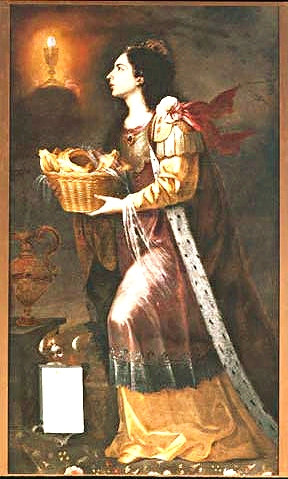 |
|
ABIGAIL
Circle of Francisco de Zubaran Spanish
1598-1664
SN 342 Oil on Canvas
by Robert Anderson, 2000
ARTIST
Francisco de Zurbaron was one of the greatest masters of the school of
Seville and is renowned for his powerful and realistic interpretation of monastic life in
17th century Spain. During the early years in Seville he was probably in contact with
other gifted painters such as Juan de Roelas, Francisco de Herrera, Diegi Velazquez and
Alonso Cano. Apart from "The Labors of Hercules" and a
large historical scene, "The Defence of Cadiz", a few portraits and some
masterly still lifes, he devoted himself almost entirely to religious works. He worked for
churches and monasteries over a wide area of Southern Spain and his paintings were also
exported to South America.
His compositionally simple and emotionally direct altarpieces,
combining austere naturalism with mystical intensity, made him an ideal
Counter-Reformation painter. His first known dated painting "Crucifixtion"
(1627) shows striking realism, brought Zurbaran immediate fame and led to numerous
commissions from other religious orders. The most characteristic of his works are the
single figures of monks and saints in meditation or prayer, most of which seem to have
been executed in the 1630's. The figures are usually depicted against a plain background,
standing out with massive physical presence.
Towards the end of his career Zurbaran's work lost something of its
power and simplicity as he tried to come to terms with the less ascetic style of Murillo.
who in the 1640's overtook him as the most popular painter in Seville. He spent his final
years in Madrid where he had gained the title of Painter to the King.. |
SUBJECT
Abigail is an Old Testament heroine whose story is told in the Book of
First Samuel. During the time that David was fleeing from King Saul he asked for help from
a man named Nabal who refused him. David was preparing to kill Nabal when Abigail, Nabal's
wife, brought food to David's starving troops. David did not attack Nabal but at a later
date when he heard that Nabal had died he met with Abigail and made her his wife.
Abigail and David are considered to be ancestors of Christ and as in
the Echarist Series of Rubens, Abigail is seen as a prefiguration of Christian concepts.
This is why she is shown being led by the vision of the chalice holding bread in her hands
as a harbinger of the Eucharist.
PAINTING
Abigail is seen as a dark haired lady dressed in a brown cloak over a
light gold dress. She holds a basket of bread in her hands and looks fixedly at a chalice
seen leading her on from the upper left side of the painting. Abigail's face is
highlighted and she wears a decorative ornament at her left shoulder from which ribbons
flow.
There is a large pitcher on a table at the left and flowers grow along
the bottom border of the painting. In the lower left we see putti holding a plaque that
spells out Abigail and some other undecipherable words.
As mentioned above, this is the depiction of an Old Testament heroine
who prefigures the Christian Eucharist.
HISTORICAL CONTEXT
Zubaran as noted above was an effective painter in the cause of the
Counter Reformation. As the Church fathers sought to renew faith in the doctrines of
Church, as well as correct abuses of the clergy they used religious art as aids to
devotion and meditation. Scenes of martyrdom and miracles were very popular in this regard
and the work of Zurbaran and his Circle were surely effective in building the desired
sense of awe and mystery in the religious feeling of Spanish Catholics - and therby
keeping Spain from the danger of Protestantism.
|